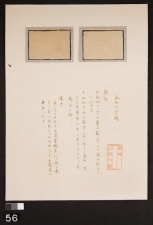Difference between revisions of "Nebatsutsuji (Rosebay) - left (56 L)"
Jump to navigation
Jump to search
(username removed) |
(username removed) |
||
| Line 1: | Line 1: | ||
| − | {| class="wikitable" | + | [[[SliderGallery rightalign|Uemura_04-16-2009_056.jpg~Normal]]]{| class="wikitable" |
|- | |- | ||
! scope="row"|Museum number | ! scope="row"|Museum number | ||
Revision as of 09:30, 8 June 2013
| Museum number | 56 |
|---|---|
| Uemera number / title | 一; 櫨染 廿五 "Haze-some 25" |
| Folder location | 1st shelf |
| Sample location | left (56 L) |
| Fiber type | cotton |
| Color | beige |
| Dyestuff (Japanese common name) | ねばつつぢ : Nebatsutsuji |
| Dye (English common name) | Rosebay |
| Dyestuff (botanical name) | Rhododendron macrosepalum Maxim. |
| Plant part | leaves /dried (?) |
| Dyestuff extraction | boiled in water |
| Auxiliary agent in dye bath | - |
| Mordant | - |
| Other auxiliary agent | ash water |
| Dyeing process | The fabric was soaked into 1) dye bath; and 2) dye bath mixed with ash water. |
| Uemera's notes | The resultant color became more beige. Note: without use of ash water, the dye compound would hardly be fixed to the fiber and generate beige yellow. In Tamba region, Japan, they use the plant for actual dyeing. |
| Uemera's date | Kyoto |
